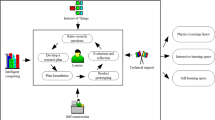Abstract
Every nation rely on latest engineering technologies to foster in today’s technological era. Wireless Sensor Networks (WSNs) is one of the latest emerging technologies being the center of interest of today’s researchers. All the researchers work hard to produce quick deliverables through Research and Development (RandD) and by applying different learning pedagogues. Currently, the learning pedagogues in Engineering RandD are Project Based Learning and Problem Based Learning (PBL). Based on these pedagogues, this paper propose and implements a hybrid pedagogy called Project Oriented PBL (PO-PBL) which is time effective and result oriented learning pedagogy. It has resulted in providing impetus to RandD in WSNs. Further the proposed pedagogy is divided into two paradigms namely PO-PBL Macro Model and PO-PBL Micro Model. We observed that PO-PBL Macro Model results in optimal number of deliverables in time restricted manner over large scale. Moreover, we have also implemented PO-PBL Micro Model, compared it with PO-PBL Macro Model and propose PO-PBL Micro Model as basis for designing self-learning algorithm for WSNs devices.








Similar content being viewed by others
References
Terry, J. van der Werff. 10 emerging technologies that will change the world. http://www2.technologyreview.com/featured-story/401775/10-emerging-technologies-that-will-change-the/, 2003.
Malumbres, M. P., Garrido, P. P., Calafate, C. T., & Oliver, J. (2009). Underwater wireless networking technologies. Encyclopedia of information science and echnology (2nd ed., pp. 3864–3958). Hershey, PA: IGI Publishing.
Shaikh, F. K., Chowdhry, B. S., Ammari, H., Uqaili, M. A., & Shah, A. (Eds.). (2013). Wireless Sensor Networks for Developing Countries. Germany: Springer Verlag.
Montero, E., & Gonzalez, M. J. (2009). Student engagement in a structured problem-based approach to learning: A first-year electronic engineering study module on heat transfer. IEEE Transactions on Education, 52(2), 214–221.
Davcev, D., Stojkoska, B., Kalajdziski, S. & Trivodaliev, K. (2008). Project based learning of embedded systems. In CISST’08: Proceedings of the 2nd WSEAS International Conference on Circuits, Systems, Signal and Telecommunications, pp. 120–125, Stevens Point, Wisconsin, USA. World Scientific and Engineering Academy and Society.
Jamaludin, N. A., & Sahibuddin, S. (2012). Challenges of a project-based learning approach towards requirement engineering. International Journal of Computer Applications, 50(3), 1–5.
Kurzel, F., & Rath, M. (2007). Project based learning and learning environment. Journal of Issues in Informing Science and Information Technology, 4, 503–510.
Pridgen, W. L. (1963). The role of the field engineer in a research and development program. Aerospace, IEEE Transactions on, 1(2), 1219–1222.
Kim, M. S. (2011). A systematic project-based learning model for accounting education in engineering and its application to web-based practice system. In 2nd International Conference on Education and Management Technology (pp. 54–59).
Lacuesta, R., Palacios, G. & Fernandez, L. (2009). Active learning through problem based learning methodology in engineering education. In Frontiers in Education Conference (pp. 1–6).
Cheng, Y., & Zhang, R. (2010). A framework of project-based integrated learning environment for animation design. International Conference on Artificial Intelligence and Education, 2010, 433–436.
Guzelis, C. (2011). Problem based learning versus project based learning in electrical-electronics engineering programs. In Proceedings of 7th International Conference on Electrical and Electronics, Engineering pp. II-40.
Puccinelli, D., & Haenggi, M. (2005). Wireless sensor networks: Applications and challenges of ubiquitous sensing. Circuits and Systems Magazine, IEEE, 5(3), 19–31.
Ye, D., Gong, D. & Wang, W. (2009). Application of wireless sensor networks in environmental monitoring. In Proceedings of 2nd International Conference on Power Electronics and Intelligent Transportation, System, 1 (pp. 205–208).
Bellido-Outeirino, F. J., Flores-Arias, J. M., Domingo-Perez, F., Gil-de Castro, A., & Moreno-Munoz, A. (2012). Building lighting automation through the integration of dali with wireless sensor networks. Consumer Electronics, IEEE Transactions on, 58(1), 47–52.
Srikanth, S. V., Pramod, P. J., Dileep, K. P., Tapas, S., Patil, M. U. & Sarat, C. B. N. (2009). Design and implementation of a prototype smart parking (spark) system using wireless sensor networks. In Proceedings of Advanced Information Networking and Applications Workshops, 2009 (pp. 401–406).
Author information
Authors and Affiliations
Corresponding author
Additional information
This research was partially supported by Mehran University of Engineering and Technology, Jamshoro, Pakistan and National ICT RandD Fund, Ministry of Information Technology, Pakistan under National Grassroots ICT Research Initiative.
Rights and permissions
About this article
Cite this article
Qureshi, U.M., Aziz, Z., Shaikh, F.K. et al. Project Oriented Problem Based Learning: A Wireless Sensor Network Perspective. Wireless Pers Commun 76, 463–477 (2014). https://doi.org/10.1007/s11277-014-1718-y
Published:
Issue Date:
DOI: https://doi.org/10.1007/s11277-014-1718-y




